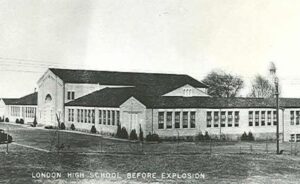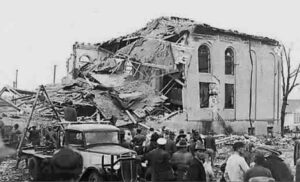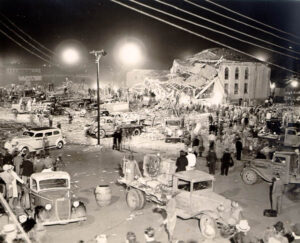 Years ago, when natural gas was first being used for energy, it had no odor, and so, if there was a leak, there was no warning. Natural gas was considered safe, and for the most part, it was, but when it leaked, and fumes pooled, any spark could be deadly. There is another kind of natural gas, called wet-gas that is less stable that natural gas, and probably should never have been used, but in the 1930s, the dangers were less known. Natural gas was more expensive, so sometimes consumers…mostly large consumers opted for the cheaper wet-gas to save a little money.
Years ago, when natural gas was first being used for energy, it had no odor, and so, if there was a leak, there was no warning. Natural gas was considered safe, and for the most part, it was, but when it leaked, and fumes pooled, any spark could be deadly. There is another kind of natural gas, called wet-gas that is less stable that natural gas, and probably should never have been used, but in the 1930s, the dangers were less known. Natural gas was more expensive, so sometimes consumers…mostly large consumers opted for the cheaper wet-gas to save a little money.
The Consolidated School of New London, Texas actually sat in the middle of a large oil and natural gas field. Texas is known for its oil and natural gas fields, and it wasn’t uncommon for towns to be build right in the middle of the fields. The area of New London was dominated by 10,000 oil derricks, 11 of which stood right on school grounds. The school, costing close to $1 million, was newly built in the 1930s and, from its inception, it bought natural gas from Union Gas to supply its energy needs. The school’s monthly natural gas bill averaged about $300 a month, and with such an exorbitant bill, the school officials were eventually persuaded to save money by switching over to the wet-gas lines, which were operated by Parade Oil Company. The lines ran near the school, and the cost to use them was definitely less. Wet-gas is a type of waste gas that has more impurities than typical natural gas and wasn’t as safe. Still, at the time, it wasn’t uncommon for consumers living near oil fields to use this gas.
On March 18, 1937, at approximately 3:05pm, a Thursday afternoon, school was about to end for the day, and  the 694 students and 40 teachers at the Consolidated School were waiting for the final bell, which was to ring in 10 minutes. It was not the final bell that was heard, but rather a huge explosion and powerful explosion shook the region. The blast literally blew the roof off of the building, leveled the school. There was no warning, because back then, natural gas was odorless. Nevertheless, in the presence of the leaking fumes, a single spark…or even static electricity, had the ability to create an explosion of indescribable proportions…and that is exactly what happened. When the blast came, it could be felt 40 miles away and most of the victims were killed instantly. From all over town, and even the surrounding towns, rescue workers and even everyday citizens rushed to the scene to pull out survivors. Surprisingly, hundreds of injured students were hauled from the rubble, and some students miraculously walked away unharmed. Ten students were found under a large bookcase that, when it fell, actually shielded them from the falling building. The rescue workers quickly established first-aid stations in the nearby towns of Tyler, Overton, Kilgore, and Henderson to tend to the wounded. It was noted that a blackboard at the destroyed school was found that read, “Oil and natural gas are East Texas’ greatest natural gifts. Without them, this school would not be here and none of us would be learning our lessons.” Yes, they were, but they could also be the greatest danger.
the 694 students and 40 teachers at the Consolidated School were waiting for the final bell, which was to ring in 10 minutes. It was not the final bell that was heard, but rather a huge explosion and powerful explosion shook the region. The blast literally blew the roof off of the building, leveled the school. There was no warning, because back then, natural gas was odorless. Nevertheless, in the presence of the leaking fumes, a single spark…or even static electricity, had the ability to create an explosion of indescribable proportions…and that is exactly what happened. When the blast came, it could be felt 40 miles away and most of the victims were killed instantly. From all over town, and even the surrounding towns, rescue workers and even everyday citizens rushed to the scene to pull out survivors. Surprisingly, hundreds of injured students were hauled from the rubble, and some students miraculously walked away unharmed. Ten students were found under a large bookcase that, when it fell, actually shielded them from the falling building. The rescue workers quickly established first-aid stations in the nearby towns of Tyler, Overton, Kilgore, and Henderson to tend to the wounded. It was noted that a blackboard at the destroyed school was found that read, “Oil and natural gas are East Texas’ greatest natural gifts. Without them, this school would not be here and none of us would be learning our lessons.” Yes, they were, but they could also be the greatest danger.
The investigators were never able to determine the exact cause of the spark that ignited the gas, noting that it very well may have been simple static electricity. Sadly, the dangers of wet-gas came more to light because of this incident, and as a result wet gas was required to be burned at the site rather than piped away. Also, as a safety precaution, a new state law was put into place, mandating the usage of malodorants in natural gas for  commercial and industrial use. This would provide a warning to anyone in the area of a natural gas leak, and hopefully prevent large casualties such as the ones felt in this explosion. The number of people estimated killed in the explosion is 294, but the actual number of victims remains unknown. The majority were from grades five through eleven, because the younger students were educated in a separate building, and most of them had already been dismissed from school. Many of the victims were only identified by their clothing or fingerprints, which was only available because many inhabitants of the surrounding area had been fingerprinted at the Texas Centennial Exposition the previous summer. Who could have known the importance of that exposition?
commercial and industrial use. This would provide a warning to anyone in the area of a natural gas leak, and hopefully prevent large casualties such as the ones felt in this explosion. The number of people estimated killed in the explosion is 294, but the actual number of victims remains unknown. The majority were from grades five through eleven, because the younger students were educated in a separate building, and most of them had already been dismissed from school. Many of the victims were only identified by their clothing or fingerprints, which was only available because many inhabitants of the surrounding area had been fingerprinted at the Texas Centennial Exposition the previous summer. Who could have known the importance of that exposition?


Leave a Reply